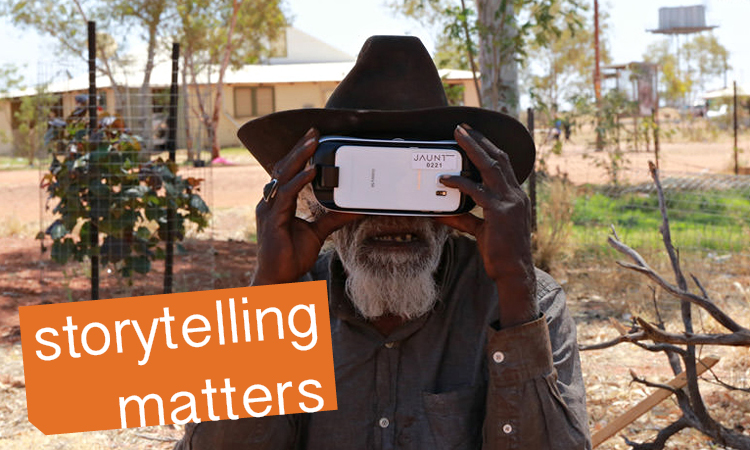
Australian aboriginal elder Nyarri Nyarri’s story “Collisions” told in the virtual reality and produced by HatchLab’s Nicole Newnham. Through the VR format, observers become participants the Martu Tribe’s experience of atomic testing in the 1950s.
 FRIDAY, APRIL 8 | BY MARY T. AN
FRIDAY, APRIL 8 | BY MARY T. AN
What happens when you put a climate scientist, a filmmaker, and an environmental activist together in a room for a day and ask them to create something? This sounds like the makings of a social experiment, or the beginning of a joke about a desert island. But it is in, in fact, a very real thing. NAMAC brought together this diverse and exciting group in late March at the Carnegie Institute for Science in DC in partnership with the Environmental Film Festival—to create urgently-needed climate stories in very new ways.
Carefully crafted stories have the unsurpassed ability to close the distance of place and time.
Climate change suffers from a public perception problem. As a society, we make the dangerous mistake of thinking that climate change is distant: geographically (it’s happening in a place far away); temporally (it will take a long long time for things to really get bad), socially (this won’t affect people like me), and with uncertainty (is it really happening?). The problem is that public perception is the most important part in the fight against global warming. Only the force of a collective and concerned public can move global leaders and lawmakers to sign binding treaties and enact difficult policies.

This is where storytelling comes into play as one of the most powerful tools available to change perceptions and forward environmental justice. Carefully crafted stories have the unsurpassed ability to close the distance of place and time. Image and sound can transport you to the Arctic to watch a city-sized ice sheet collapse into the ocean in just 75 minutes (here’s a 20-second time-lapse of this happening in Jeff Orlowski’s breathtaking Chasing Ice). This video makes my pulse quicken—it is mesmerizing, heartbreaking, and more effective than any amount of statistics and facts on paper, however cleverly presented. After watching, I shared it on social media, emailed it to friends, and talked about it with gusto at social gatherings—especially to those who don’t really care about climate change—because the beautifully-presented and digestible images have the power to captivate anyone’s attention.
NAMAC HatchLabs are designed to create captivating stories to effect change. Meaningful stories result from true collaboration, and they rise up from communities most vulnerable to climate degradation but also most systematically excluded from the climate conversation. HatchLab redefines environmental storytelling through a shared creative process. Ideas are seeded equally between scientists, mediamakers, activists and affected communities. These diverse elements emulsify to create new ways of describing complex climate concepts that will engage an individual’s intellect and emotions, shift their perceptions, and ultimately have some impact in the world.

I’ll give an example. During the DC Lab, Climate scientist Dr. Brenda Ekwurzel shared the catastrophic phenomenon of melting permafrost which will release 130 billion tons of carbon into the atmosphere by year 2100; roughly 100 times the current U.S. annual carbon emissions from fossil fuels. This little known event has big global consequences. Even in simplest terms, the concept of melting permafrost is incredibly difficult to grasp. This is where Brenda’s Lab team member, media maker Liz Miller, stepped in to imagine an interactive project which shows permafrost melting in the arctic, overlaid with visuals to describe the carbon emission, and then takes the viewer on a circumnavigation of the globe to witness resulting floods in Bangladesh. Local communities and grassroots organizations would co-create the project to relay their point of view and to communicate the impact on their livelihood. In this way, complex concepts become lived experiences. A viewer can immediately grasp the data-driven ideas, feel the implications, and connect it to environmental degradation and vulnerable communities far away. This is the recipe for creating stories that alter perceptions and inspire change.
The exciting new story ideas seeded at HatchLab are powered by scientists who can shape the content, media-makers who are able to craft the story, activists and communities who will breathe life into the project.
Permafrost virtual reality is one of fifteen new project concepts that were envisioned in the course of nine hours at the HatchLab in DC. Other projects include: a multimedia hero’s journey chronicling headwaters in Peru flowing through the Amazon and into the ocean; a tour of California’s San Gabriel Valley mapping toxicity levels through childhood cancer clusters; a film on the life a piece of GMO fruit from seed to consumption; and an interactive media roadshow about ubiquitous but unknown HFC-34a, used to make insulation in your refrigerator, which is 1000 times worse than carbon dioxide.

These exciting new story ideas seeded at HatchLab are powered by scientists who can shape the content, media-makers who are able to craft the story, activists and affected communities who will breathe life into the project. The elements come together powerfully to produce resonant storytelling that can connect communities, change public perception, inform policies, and influence grassroots change. In other words, these newly seeded ideas are in the hands of the people best suited to tell the story and to place it into the world in a meaningful way.
Mary T. An is the Impact Producer for NAMAC’s HatchLabs initiative, funded by the Rockefeller Foundation. She is also the Development Manager for American Documentary | POV, a NAMAC member organization. She has an international public policy background and is passionate about the transformational powers of media.
STORYTELLING MATTERS is a blog series at NAMAC featuring original and curated writing and photography about global story culture and innovation in the hopes of facilitating conversation about the ethical and responsible use of creative technologies in community. If you have a story to share for the series, let us know! creative@namac.org


Leave a Reply